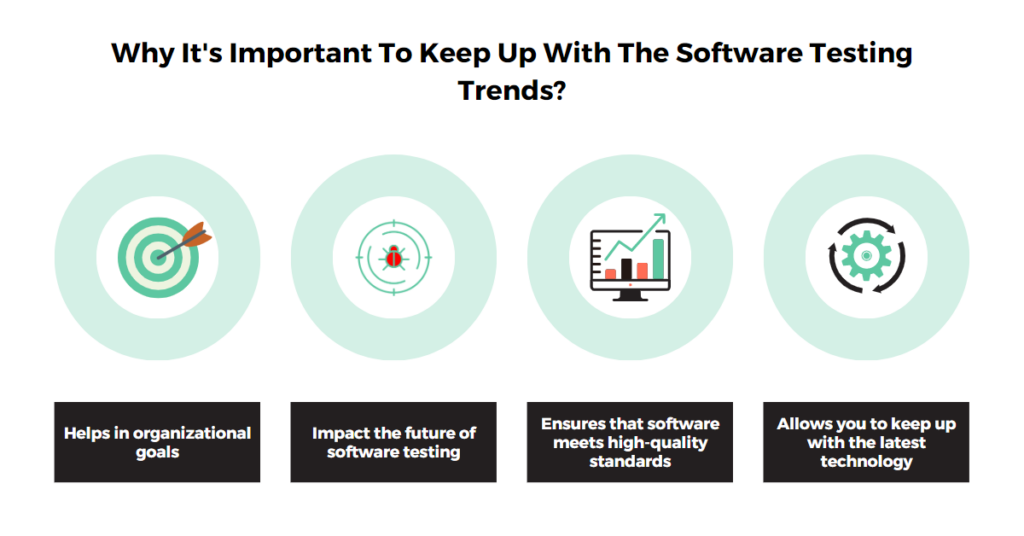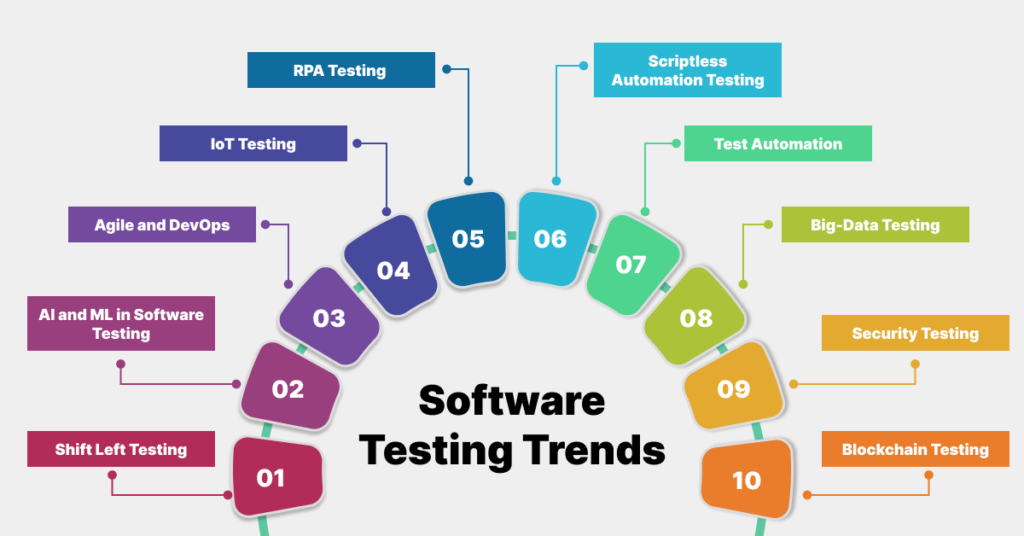Software testing is an ever-evolving field, and it is essential to stay up-to-date with the latest software testing trends and best practices to deliver high-quality software products. The future of software testing looks bright, and we can expect significant advancements in the industry in the upcoming years.
According to GMinsights’ most recent report, Automation Testing is valued at USD 20 billion and is anticipated to grow at a 15% CAGR between 2023 and 2032.
The IT industry is witnessing significant changes in software testing, and the latest trends show that continuous testing is becoming the norm. Development teams are adopting best practices to ensure quality assurance, and the focus is shifting toward improving the user experience of software products. With the increasing demand for software tools and the adoption of Agile methodologies, the QA team and software testers play a critical role in ensuring the success of software development life cycles. This increase is due to the rapid adoption of advanced technologies by businesses. With software serving as the primary interface between developers and customers, the emphasis on software quality is growing. Additionally, software teams are trying to keep their composure to produce high-quality, bug-free products in ever-faster cycles. Therefore, software testing needs to use new techniques to keep up.  Here is a list of the top testing techniques to look for in 2023:
Here is a list of the top testing techniques to look for in 2023:
The Top Software Testing Trends for 2023
The increased use of automated and AI-based testing methods is one of the most recent trends in non-functional testing. Machine learning algorithms identify and prioritize application areas that might be more vulnerable to performance or security issues. Shift-left testing, which seeks to discover issues early on in the development process rather than delaying them until later testing or deployment stages, is also receiving more attention. The practice of testing applications in the cloud rather than on physical hardware is another trend. It enables greater testing flexibility and scalability. Trends in software testing involving test automation enhance the procedure’s effectiveness, economy, and dependability. These trends will continue to influence how the test execution in software occurs and is deployed as it develops. Now let’s go into greater detail about the trends that will influence software testing in the future.  Let’s explore these trends in detail!
Let’s explore these trends in detail!
Shift Left Testing
Shift left testing is typically carried out earlier in the software and system development lifecycle. It helps identify potential issues and bugs before they can become significant issues. It enables the team to spend less time debugging and more time concentrating on features and functionality. Shift-left testing averts all adverse effects that late testing could have, such as insufficient testing resources, undetected design, architecture, and requirement flaws, debugging challenges and problem resolution, and project delays. There are four ways to move tests to earlier stages of the software development cycle. These include model-based shift-left testing, traditional shift-left testing, incremental shift-left testing, and Agile/DevOps shift-left testing.
Artificial Intelligence and Machine Learning in Software Testing
As testing becomes more automated, trends in software testing that involve AI & ML technologies improve testing processes. For example, using AI algorithms to create test cases and ML techniques to find patterns and anomalies in test data. Organizations can improve the efficiency and accuracy of their testing processes and produce more dependable software of higher quality by utilizing AI and ML algorithms. The use of AI and ML in automation testing will grow and keep evolving as businesses look to speed up, improve accuracy, and streamline their testing processes. It will result in software testing benefiting from new and improved algorithms.
Agile and DevOps
The term “agile” refers to a software development philosophy that focuses on teamwork, client feedback, and ongoing improvement. DevOps is a technique to develop software that uses an array of tools that work together to offer quick delivery procedures for a shorter time to market. Software Testing can effectively carry out and efficiently thanks to the synergy between Agile and DevOps. The DevOps teams can quickly deliver the software by using modern tools and procedures. Some of the most popular tools used in DevOps processes are AWS, Google Cloud Platform, Jenkins, Azure, and Docker. When used properly, these tools can assist software testing teams in enhancing the testing process and gaining more understanding of how their products will function in different situations.
IoT Testing
IoT testing is becoming more popular with the growth of the Internet of Things. The Internet of Things (IoT) is a system of electronically and electronically connected physical objects, such as cars, appliances, and other household items, that can communicate with one another and share data. IoT testing has experienced rapid growth due to the growing importance of security and functional testing to ensure the effectiveness and efficiency of these devices. It is essential to ensure that IoT systems and gadgets live up to users’ expectations and work as expected.
RPA Testing
Software testing has already incorporated robotic process automation, and we anticipate that trend to continue in 2023 with increased acceptance.
By 2027, research and market surveys predict that RPA will generate about 3.4 billion US dollars in revenue. RPA is preferred as the first option for performing the automation of repetitive tasks, with a year-over-year growth rate of 28.2%.
RPA, also known as robotic process automation, is a method of automating repetitive tasks so that they do not require manual intervention. RPA records the tester’s actions for the first time and then uses machine learning to run numerous scenarios using the same on-screen actions. This automation feature helps businesses save time and money.
Scriptless Automation Testing
Scriptless automation testing, also known as codeless testing, automates tests using tools instead of customary manual scripting. This method simplifies manual testing and accelerates the entire process by enabling testers to quickly and effectively create, run, and analyze tests. Testers can quickly automate tedious tasks and clear out time-consuming manual processes involved in test creation by using scriptless automation tools. It helps developers save time when writing code for various testing scenarios when running and analyzing test results. Some of the top scriptless test automation tools in the software testing sector include ACCELQ, Kobiton, Cerberus Testing, and TestComplete.
Test Automation
Test automation has several advantages over traditional manual testing methods. First and foremost, it can significantly speed up and streamline the testing procedure. Automated tests can be executed quickly and frequently, enabling more thorough testing in less time. Large, complex software applications that would be challenging and time-consuming to test manually may find this especially useful. Testing automation also has the potential to improve the precision and consistency of test results. In manual testing, it is typical for different testers to interpret test instructions slightly differently, which can produce inconsistent results. On the other hand, automated tests are consistent and give accurate and reliable results. Test automation can reduce the cost of software testing. Automated tests can be executed quickly and frequently, enabling more thorough testing in less time. It can reduce the time and resources needed for testing, resulting in cost savings for the software development team.
Big Data and Data Analytics Testing
Software testing trends in Big Data and Data Analytics are shifting towards automation and specialized tools to handle the complexity and variety of data. It refers to examining and approving data processing programs and pipelines that manage sizable amounts of data in various formats. Verifying data ingestion, storage, processing, analysis, visualization, and modeling is all part of the testing process’s broad scope. Testing validates real-time data processing while ensuring data quality, accuracy, and consistency. The complexity of big data systems expands the scope of testing and necessitates specialized skills and equipment to verify the accuracy of the processed data.
Security Testing
The software testing trend is currently focusing on incorporating security testing into the software testing life cycle to protect users’ data from growing digital threats. Security bugs can have disastrous effects due to the complexity of cyberattacks, leading to monetary losses, reputational damage, and the loss of sensitive data. Because of this, businesses now give more importance to testing the security of their systems, making security testing an essential part of software development. The scope of security testing will broaden as the need for secure software and the complexity of software systems increase, enabling companies to ensure the security of vital systems like those used in finance and healthcare.
Blockchain Testing
As ledger-based technology has grown in popularity, blockchain has become one of the most sought-after technologies globally. Its applications range from protecting financial transactions to sharing corporate data safely. Blockchain testing aims to evaluate the security and dependability of the shared ledger that connects various blocks. These blocks with a specific node in a cluster will contain different software system applications. Blockchain testing not only examines security but also the load ability and scalability of blockchain databases and ledgers. In addition to testing, it adheres to agile development methodologies taught in associate programs.
The Evolution of Software Testing Trends 2023
Businesses must be aware of the most recent testing trends in 2023 because they will impact testing in the future as technological advances occur. Testers must be aware of these trends and incorporate these technologies into their regular testing tasks to remain competitive in the software testing market. Due to these trends, businesses can anticipate a higher ROI from software testing activities. Utilizing these trends in automation testing will enable them to test more software faster and in more diverse ways. Continuous testing will continue to be a critical component of the software development life cycle, and quality assurance will play a crucial role in ensuring software quality. Software testing will remain a top priority for businesses with the increasing focus on user experience and the demand for seamless software products. As the software industry continues to evolve, software testers will need to adapt to the different features of various devices, catering to the needs of both business users and end-users. QA engineers should stay up-to-date with the latest software testing trends to deliver high-quality software products with great demand across industries.
FAQs
What is the future of software testing?
The future of software testing involves automation, no-code, and AI-assisted testing. Although there are conflicting opinions about these technological trends, automation will significantly alter and simplify testing for everyone.
Will Selenium be used in 2022?
Yes, many testing technologies and automation tools are built on the Selenium platform, which makes them more stable.
Which software testing technique is the most demanding?
The organization embraces Agile in response to rapidly shifting requirements, and DevOps has been embraced in response to the need for speed. With NoOps and DevTestops, the future of testing could soon change.
What is the fundamental goal of QA automation?
The main goal of QA automation is to reduce or eliminate human intervention, accelerate development, boost efficiency and dependability, and quickly provide feedback to accelerate development processes.








